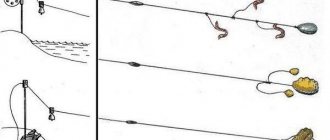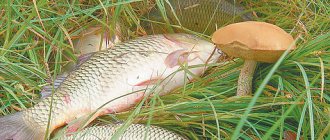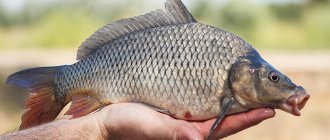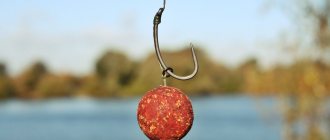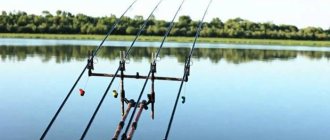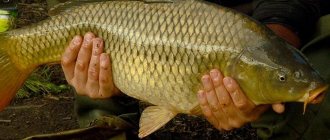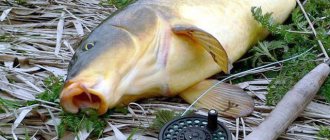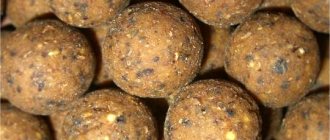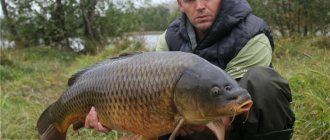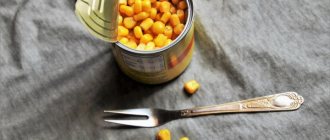A huge variety of different gear is used to catch carp, but fishing for carp with mugs has always been very popular. First of all, because it allows you to successfully catch inactive carp, which is often the case in mid-summer and autumn.
This does not mean that the fish stop feeding altogether. She just grabs the food that is in the immediate vicinity. In this article we will take a closer look at what a carp circle is and how to catch it.
Does it make sense to fish with mugs?
During the spring zhora, carp actively moves around the reservoir in search of food, so finding and catching it is not difficult with any tackle . In this case, it is more convenient to use a float rod. However, from the beginning of summer until September, the carp has already fattened up, and its activity is reduced to a minimum. In summer there is plenty of food in any part of the reservoir , so carp prefers safe places like deep holes and other natural shelters, often far from the shore. It rarely moves, which means it is very difficult to find.
Racks for carp and carp help place the tackle anywhere on the pond. And if you consider that you can place several circles, then the efficiency of fishing increases significantly . At the same time, you can deliver bait to the most potentially “fishy” places without significant effort . In addition, carp become timid and avoid any extraneous sounds . A banal blow of the rod on the surface of the water can make the fish refuse food . The mugs, in turn, make absolutely no sounds .
The feasibility of circles
Mugs for carp are an unexpected (since many are accustomed to the fact that they are more often used for pike), but effective tackle. They perform best in summer and early autumn, when high water temperatures make the carp lethargic and greatly suppress their appetite. At this time, carp are difficult to catch with conventional float rods. Even with a professional carp fishing rod, good fishing in the summer is not guaranteed.
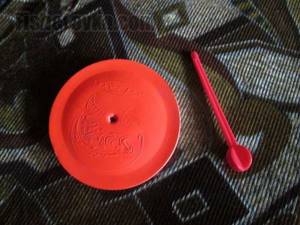
Photo 1. Elements of a circle.
In the summer, when the post-spawning feeding period ends, the carp loses feeding activity. He becomes fearful and overly cautious, goes deep into shady places, holes and other shelters, which he prefers not to leave even for food. This peaceful omnivorous fish slowly eats up the food available in the parking area, as well as that brought by the current, but that’s all. It does not migrate across a body of water in search of food and does not take ordinary fishing baits well. He is frightened by the sound of equipment falling into the water. That is why mugs are especially effective for catching this fish. They create almost no splashes or sounds when installed and do not cause concern to the carp. At the same time, the fisherman does not need to sit for a long time with a fishing rod in his hands - it is enough to install several circles in the intended parking area and calmly do other things.
How many circles can be placed according to the law? Depends on regional fishing standards if the reservoir is state-owned, and on the opinion of the owner if it is private. Thus, in the Leningrad region 10 circles are allowed, while in the Moscow region - only 5 per person. At the same time, persons with a fishing license in a particular region may have certain benefits.
Attention! How many circles can be placed on a private pond, and whether it is possible at all, is decided solely by its owner.
It is also advisable to take into account the area of the area fished using girders.
Arrangement of circles

- A round disk with a groove is used as a float and reel at the same time. It is made from lightweight buoyant materials . It can be wood, plastic or foam. Such tackle can be found in any fishing store or you can make it yourself. The diameter of the disk should be approximately 10-12 cm, thickness up to 3 cm. The groove is made up to 1 cm deep, depending on how much fishing line is placed in it.
- Rod - inserted into the float disk . passes through it and is fixed , so there should be small grooves in the rod . Length – up to 20 cm .
- Line - the main line that is wound onto the disk . For carp fishing, 0.24 - 0.3 mm monofilament fishing line is sufficient. large specimens of more than 10 kg in the reservoir 0.4 mm or use braided wire. You will need about 30-40 m of fishing line.
- Leashes are attached to the main line using a knot or carabiner. It is advisable to use thin leashes no more than 0.2 mm or less from braided fishing line . The length of the leashes is 30-40 cm . The color must match the fishing conditions, that is, the bottom. 1-2 leashes on one circle . Experienced fishermen limit themselves to one leash, as several pieces can get tangled or overlap.
- Sinker - attached to the main fishing line , possibly in the same place where the leash is attached. To prevent overlapping, a branch is used . For fishing in still water 15-20 g of sinker weight is enough during currents, double the weight or tie the tackle to aquatic vegetation, if possible.
- Hooks – use single and double types of hooks, but specifically carp hooks. They have a special design to increase the chance of successful hooking. Hooks are not suitable for predatory fish. The size of the hooks depends on the size of the carp in the pond .
Important! Carp mugs can be used for pike fishing and vice versa. The gear is very similar.
Useful tips
- If you make mugs for carp yourself and choose wood as the material for the disc, then give preference to linden (spruce or pine will do). It is lightweight and easiest to process. Naturally, the wooden circle must be soaked in drying oil and covered with waterproof paint. Otherwise, the tackle will quickly fail.
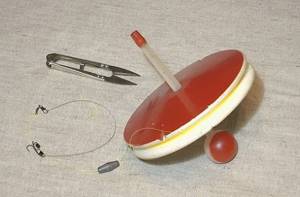
When making mugs for carp fishing, you should consider some nuances
- In many reservoirs, carp can be very cautious and even shy. To catch such fish, it is better to use a smaller version of circle gear. That is, the diameter of the circle is no more than 10 cm, and the thickness is approximately 1 cm. If you use large circles, then there is a high chance that the splashes when they are turned over will frighten the carp.
- Carp are successfully caught with mugs even in hot weather, when it swims near the surface. To do this, the sinker is removed from the tackle, and bread (or even crusts) or floating boilies are placed on the hooks. The latter version of the attachment is more preferable, because the bread crust and even crackers quickly become soggy and easily fly off the hook.
- When fishing for carp with mugs, proper fishing plays an important role. After all, if you give the fish a little slack, it will easily go into the snags. At the same time, carp are a big fan of swimming around some obstacle several times. The same branch or snag. As a result, it is no longer possible to pull out the fish - all that remains is to cut or tear the fishing line.
In the video we will talk about catching carp with mugs:
What to catch?

It is only important to understand that carp prefers high-calorie food; it will not waste time eating small fractions or worms (we are talking about large individuals). Carp loves large and satisfying pieces of food.
The following types of baits and attachments are used to catch carp
- small potatoes;
- corn (boiled or canned);
- peas;
- May beetle larvae;
- large worms;
- a bunch of maggots or bloodworms;
- dough;
- semolina;
- berries (strawberries, plums, cherries, etc.);
- pearl barley;
- cake;
- boilies.
Large baits are placed on the hook one by one, small ones in bunches or several pieces. You can mix baits and attachments, for example, attach a bunch of maggots and an additional 1-2 pieces of pearl barley. Carps love “sandwiches” .
Dill, cake, sunflower oil, anise, hemp oil, linseed oil, and vanilla are used as flavoring agents for baits Under no circumstances should you mix flavorings - this will definitely scare away the fish. Carp have a highly developed sense of smell, so a small amount of flavoring, for example in semolina or dough, is sufficient.
Nozzles for carp fishing with mugs
The hooks can be fitted with all baits that are commonly used for carp fishing. These are, first of all, boilies, peas, canned corn, various boilies, bunches of maggots and worms, briquettes of corn, etc.
If necessary, hair equipment is used. When you need to fix a boilie, a ball of potato or a briquette with mashed potatoes, then this equipment will be just right.
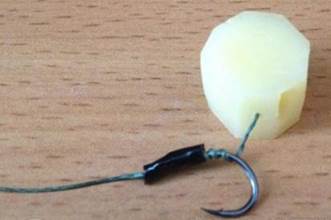
The bait should be large enough so that small fish do not annoy or interfere with fishing.
When fishing for carp in extreme heat, instead of a sinker, it is better to tie another hook and place a crust of bread soaked in sunflower oil on it. The nozzle will be located next to the circle. Carp often swim in the upper horizons in hot weather and are quite capable of taking bait in the water column. When a bite occurs, the circle will turn over.
A very effective method is to hang a feeder with corn or other bait under the circle. You can use a piece of nylon tights as a bag. It holds quite a lot of food. In the water, it seeps through small cells and the fish are quickly lured to the spot. If the wind has risen on the reservoir or the current has increased, then it is better to tie a fishing line to the circle, which is first tied to the coastal reeds.
It is best to catch carp in the water using floating boilies. They have different dissolution times. Instant boilies are designed for catching active carp in still waters. Long-soluble boilies are used when fishing for passive carp in reservoirs with a current. If you wish, you can make boilies yourself. You can read how this is done in this article.
Lure

They take one thing as a base millet porridge is best, to which they additionally add something aromatic, for example, cake, and always a small amount of large fractions (corn, peas, nuts, mixed feed, boilies, berries, etc.).
overly saturate the complementary foods - this, again, can scare off the carp. In fished reservoirs, it is unlikely that anything will scare off the carp, but in “wild” places to offer carp cherries or boilies with an exotic taste as bait or bait.
Complementary food is thrown into the water right next to the circles. The consistency of the bait should not be too wet , but not dry . You need to sculpt round balls that should not fall apart upon first contact with water, but also not be overly dense. Humidity is selected individually. You can check the condition of the bait near the shore in advance. If the balls begin to fall apart only at the bottom, and gradually, then the humidity of the bait is suitable.
Advice. To moisten the bait, it is better to use water from a pond. Additionally, you can add a handful of soil taken from the shore. This will lull the carp's vigilance and reduce the chances of the fish being spooked by unfamiliar smells.
Bait for carp and carp
Features of the gear device
This gear for carp almost completely replicates the design of the pike version, except that the diameter of the circle itself in the case of peaceful fish is somewhat smaller.
Actually, the circle itself
A circle is nothing more than a disc made of lightweight material that can float on the surface of the water. It must be well painted, otherwise there is a risk that the tackle will quickly become unusable. Sometimes spools of fishing line of suitable diameter are used as a circle. At the same time, the option for carp is usually smaller than the pike one and is not painted in bright colors so as not to scare away wary fish.
Mast
Which simultaneously performs the function of a keel. A fishing line is fixed on one side, while the other ends in a ball, which, when bitten, when the disk turns over, indicates that the circle should be checked for a catch.
Main line
When choosing a diameter, you should focus primarily on the expected size of the catch. For relatively small carp, a fishing line of 0.22-0.26 millimeters is also suitable, but for a more serious catch weighing 3 or more kilograms, it is worth choosing a fishing line with an appropriate breaking load.
Leash
The diameter of the leader depends primarily on the diameter of the main line. The leash, naturally, should be somewhat thinner. For reservoirs with high fishing pressure, fluorocarbon options that are invisible in the water are a good choice. It is either tied to the main line with a knot or with a swivel. The length is usually small, up to 30–40 centimeters.
Sinker
A small sinker is suitable, most often it is an olive, weighing about 15–20 grams; a heavier weight is usually not particularly necessary, because carp is not one of those fish that likes strong currents.
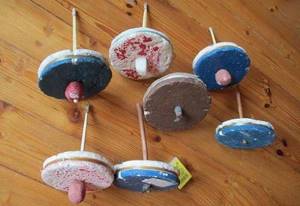
It is generally accepted that carp circles should not be too bright so as not to frighten wary fish. Important! Instead of one hook with a nozzle or a hook with a hair rig, you can use various multi-hook options like a “cork” or “carp killer” rig. These are completely unsportsmanlike, but quite effective gear with a self-hooking effect.

Carp killer or crucian carp killer. Such tackle, used on carp circles, especially with a large number of hooks placed, is practically a poaching tool.
Choosing a fishing spot
The best places for carp fishing in the warm season are:
- deep holes;
- underwater shelters (snags, fallen trees);
- coastal vegetation (overhanging bushes, thickets of reeds or reeds);
- sharp drops in depths;
- creeks and washed with considerable depth;
- holes after rapids (on rivers).
Carp can bite throughout the day , but the most successful may be at night and early morning , when the fish are less careful.
How to fish with mugs?
After equipping the circles, they are thrown into the water . The easiest way to do this is from a boat . It is enough to throw the sinker to the bottom or tie the tackle to something, for example, to the reeds. The sinker will sink to the bottom, and the line will be released from the disk itself. The distance between circles must be at least 10 m .
Attention! It is important to install the mugs without unnecessary noise so as not to scare away the fish.

There is no need to rush and rush into the water for fish. It is better to wait until the carp hooks itself and only then swim so as not to scare it away. A hooked fish will swing the circle and pull off the line.
First of all, a hooked carp tends to go deeper or to another shelter. Large fish will have to be starved out. Carp have strong and thick lips, so the hook digs into them reliably, but still you shouldn’t force things The fish must be prevented from swimming, thus depleting its strength. After the carp is exhausted, it can be dragged to the shore. However, every 20-30 seconds the fish will try to make another jerk. If you manage to lift the carp to the surface of the water, it will lose consciousness for some time from the large amount of oxygen, in this case it will be very to pull .
Video of carp fishing with a circle:
Features of catching carp on a circle
For one place it is enough to use no more than 6-8 circles. We place them away from each other with a minimum distance of 6 m. When biting, a powerful carp can pull the tackle along with it and confuse it with other circles. And as we know, unraveling the knots of a fishing line, and even several pieces of gear, is not a pleasant pleasure.
When a carp bites, the circle spins like a top, but you don’t have to hook it right away, otherwise you can tear off the carp’s lip, be left without a trophy, and even harm the fish. We hook when the line is fully untwisted - at this moment the circle usually dances like an ordinary float on the water. This means that the carp is firmly seated on the sting.
When fishing for large prey, you should not rush, but let the carp exhaust itself. You must feel every beat of the prey, every vibration and make an effort when the carp floats to the surface sideways. This position shows his fatigue.
TAGS:
DIY mugs
The design of carp circles is extremely simple. First you need to make a round disk with a diameter of 15-20 cm. The material must be buoyant. Foam or wood works best A groove up to 1 cm deep is made along the rim of the disc 0.5-1 cm hole is drilled in the center of the disk a rod is selected to it. There should be a hole in the rod itself for the fishing line.
Then the main fishing line is wound onto the disk, and a leash with a hook and a leash with a sinker . The tackle is ready.
Classic foam circle
Today, the construction industry uses a huge amount of modern materials for thermal insulation. They differ in thickness and porosity. To make circles, dense foam or polystyrene foam with a thickness of 20 mm is suitable. A lightweight metal-plastic tube with a diameter of 15 mm can be used as a pin.
- The main work will consist of cutting out round pennies from foam plastic or penoplex and their subsequent processing. First, the sheet is marked. To measure a dozen identical pieces with a diameter of 120 mm, you can use a CD-shaped template and a regular pencil. For cutting, it is better to use a sharp stationery knife or jigsaw.
- A rather problematic step in the manufacture of a mug is the formation of a groove in the end around the entire circumference. Its depth is approximately 10 mm. To process foam plastic or penoplex, you can use a knife and round files. The hole in the middle of the circle is made using a drill, the diameter of which should be smaller than the thickness of the tube.
- The final processing of the discs is done with fine-grained sandpaper. After removing dust from the surface, you can begin painting. It is best to make the top part red, the bottom half remains white. On the surface of the water, both of these colors are clearly visible from afar.
- All that remains is to make two cuts for the fishing line in the upper part of the circle. They should be on opposite sides of the circle.
- Now you need to cut a piece of tube 120 mm long. On one side, cuts are made at the end of the workpiece.
- To equip the circle you will need 10-15 m of monofilament with a thickness of 0.40 mm, a sliding lead weight of 10 g, and a metal leash 20 cm long with a double or tee.
Tips for catching carp/carp with mugs
When fishing for carp with mugs, you need to follow a few useful tips:
- first clarify how many mugs per person can be used. Usually the maximum allowed is 5-10 pieces . There may be members of fishing clubs and license .
- The distance between the circles should not be less than 5 m become tangled after a bite .
- It is better to throw mugs from a boat . This practically does not scare the fish and allows you to deliver the tackle to the right place without problems.
- It is recommended to equip mugs with various types of attachments and baits. After the first bites, it will be possible to draw conclusions about the preferences of the carp that day.
- Carp are voracious, so it is difficult to overfeed them. You can throw up to 0.5 kg into the place where the mug is thrown every 3-4 hours .
- It is better the forend of , although this is not a necessary condition. The fact is that carp sometimes prefer to savor the bait, and only then swallow it. If the fore-end sticks out, the fish may prick itself and spit out the bait.
- The location of carp activity can be seen by characteristic splashes in the water. This means the fish is feeding and is ready to bite .
Mugs can be a real lifesaver. The gear is simple, convenient and most importantly effective. It can be installed anywhere in the reservoir literally under the nose of the carp. If the fish likes the bait, then a bite is guaranteed. Feeders and float rods do not allow you to fish large areas of a reservoir at the same time, therefore they are less effective, especially in the summer .
Fishing techniques and tactics
If you are fishing together, then you should not use more than 10 equipped mugs, and there is no need to scatter them all over the pond. It is best to keep the distance between gear within 10-20 meters. Of course, if weather conditions, the size of the reservoir and your fishing experience allow you to use more circles, then this should definitely be used.
After all the mugs have been installed and the fishing spot is well fed, the fisherman can only swim to a distance of up to 50 meters and quietly wait for a bite. It is very important not to make noise on the boat, otherwise you may scare away the fish.
Immediately after the bite, you will see the circle turn over and begin to turn around. But you shouldn’t quickly follow him and rush to hook him. It is best to wait until the tackle goes under the water or suddenly begins to move to the side.

Also, do not forget that carp is a strong fish, so the fishing line must be constantly taut. If you loosen the tension of the fishing line, the carp will definitely begin to make desperate jerks and the likelihood of the tackle breaking or the fish disappearing will increase significantly. When you bring the fish to the boat, it is best to use a landing net.
From all of the above, we can conclude that fishing for carp with mugs is a very simple and interesting activity that can bring the fisherman an unforgettable experience and a big catch. If you are attentive to the manufacture of equipment and preparation for fishing, then there will be no problems, and you will be pleased with the catch.
